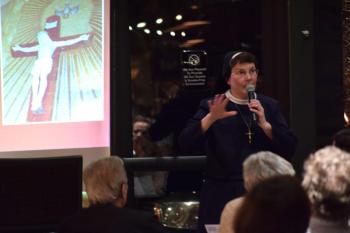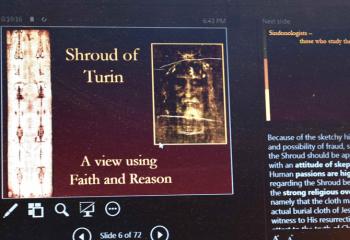By TARA CONNOLLY Staff writer
“The Shroud of Turin always intrigued me. During Lent it is a great time to reflect on the Lord. In looking at the shroud, we are remembering Christ’s passion and living it in our hearts,” said Sister Rose Mulligan, vocations director for the Sisters, Servants of Immaculate Heart of Mary, Immaculata at “Faith and Spirits.”
Sister Rose presented the talk Feb. 26 at P.J. Whelihan’s Pub, West Lawn for more than 70 faithful interested in the answers to the focus of the talk: What is the Shroud of Turin? Where does it come from?
Sister Rose opened “Faith and Spirits,” which was created to provide a forum for adult Catholics to learn more about their faith in a comfortable setting, by explaining her research on the shroud was performed using a lens of faith and reason.
“Tonight we will talk about distinguishing between facts and speculation. The foundation of our Church does not rest on if the shroud is proven to be the actual burial cloth of Christ. It does not change our faith,” she said.
Believers say the 14-foot shroud, one of the Church’s most mysterious and often revered icons, was used to cover the body of Christ after his crucifixion. The icon, though blackened by age, bears the faint but distinct impression of a human form both back and front.
“The Church is hesitant to call it a relic, which is an object touched by a saintly person or a piece of bone from a saint’s body. Pope Francis refers to it as an ‘icon’ of a man scourged and crucified,” Sister Rose pointed out,
‘The image is of a man who was 6 feet tall. The cloth itself is a linen cloth featuring herringbone twill. The image also has over 100 marks from a whip and shows a physically traumatized man similar to trauma suffered during crucifixion,” said Sister Rose.
Documents and clear descriptions of the linen date back to the 14th century when it belonged to a French knight, Geoffroy de Charny, who exhibited it in a church in Lirey, France. In 1453 it was passed to the Savoy family, who moved it to Chambéry, France, where it was badly damaged in a 1532 fire and still bears water and scorch marks.
In 1578 it was taken to Turin, Italy by the Savoy family, which would later become Italy’s monarchy. The last king, King Umberto II, who was exiled in 1946, bequeathed it to Pope John Paul II at his death in 1983.
“Although the shroud is presently housed in Turin, the Church technically owns the cloth,” said Sister Rose.
She went on to outline other features of the naked image on the cloth, including swollen eyes, a disjointed nose and unfractured legs.
“The image also shows a nail going through the wrist and not the hand. Most experts agree that crucifixion was performed with nails penetrating the wrist,” said Sister Rose.
Another fascinating piece of evidence, according to Sister Rose, is the first photograph of the shroud taken by Seconda Pia, an amateur photographer on May 28, 1898. While developing the photographs, he noticed that negatives showed a clearer rendition of a man and face that could not be seen with the naked eye.
“He almost fainted when he saw the images,” she said.
Sister Rose said many experts have stood by a 1988 carbon-14 dating of scraps of the cloth carried out by labs in Oxford, Zurich and Arizona that date the cloth from 1260 to 1390, which rules out its use during the time of Christ.
But a new test, by scientists at the University of Padua in northern Italy, used the same fibers from the 1988 tests, and disputes the findings. It dates the shroud to between 300 BC and 400 AD, which would put it in the era of Christ.
Sister Rose then discussed aspects of the blood soaked into the linen and said experts agree that dark-colored blood entered the linen first and then the image.
“That piece of evidence rules out that someone may have painted the image. The blood also had high levels of bilirubin that a body produces when it’s in a state of high anxiety and gives it a deep red color,” she said.
Sister Rose then referred to Holy Saturday, March 30, 2013, when the images of the shroud were streamed on various websites, as well as on television for the first time in 40 years.
“That brought back interest and excitement to the shroud. Pope Francis issued a statement urging us to not simply look at the shroud as a form of veneration but a way for Jesus to look at us,” she said.
“I also encourage you this Lent to take the time to meditate on the Passion of Christ. It is there where we see how much God loves us,” said Sister Rose.














